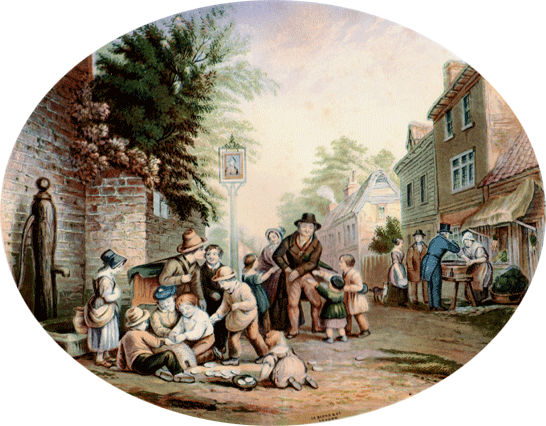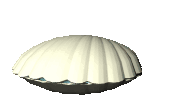|
Mitcham Grottoes and Grotto Day
Fair Green
Mitcham
Surrey
United Kingdom
Please remember the grotto; it's only once a year
Please give me a ha'penny to spend at Mitcham Fair
Father's gone to sea;
Mother's gone to fetch him back
So please remember me.
'Penny for the grotto' (more often pronounced grotta in local parlance) was the way by which Mitcham children attempted to raise money to spend at the local fair held on Fair Green annually in August.
The structures the children produced at kerb sides were made of earth, shells, tawdry odds and ends of ribbons etc., bits of mirror or scraps of silver paper to represent water, and flowers 'borrowed' from local gardens. Perhaps some went so far as to scoop out a cave but this was by no means essential. Grottos could also constructed on old trays so that they could be transported to more lucrative sites or moved swiftly out of sight of disapproving parents or adults likely to snitch. Passers by were asked to give 'a penny for the grotto' so it paid for it to be as elaborate and decorative as possible.

Please remember the grotto - La Blond mid 19th century print London.
It is probable that most of the children making grottos had no idea of the 18th century constructs deemed necessary for a fashionable landscaped garden of the gentry. Jackie Godfrey gives the following first-hand account of grottoes in Mitcham.
"There was a very rough area of Mitcham known as Rocky or Redskin Village, now known as Phipps Bridge - the Wandle runs through there. The children, from what I am told, were ragamuffins and obviously looking for any opportunity to get the odd penny - my mum grew up there until they were 'bombed out' in the war - she was probably around 15 at the time. However my aunt (dad's sister) lived in a slightly better area of Mitcham and she too had made grottos. The Hadfeild estate (now the National Trust Morden Hall Park) hosted parties in the summer for the local children, i.e. those from Rocky, - boating etc. on the Wandle which runs through the estate as you know. I will talk to my cousin (she is 77 and grew up near Phipps Bridge)."
'Mysterious Mitcham' website suggests the tradition died out in 1950/60s. (Click Website below to view) The illustration and Mysterious Mitcham web site suggests that children's efforts to elicit money by building grottos was more widespread and a practice that prevailed over many years. It is also suggested that the custom of building grottoes may derive from the celebration of St James's Day (25 July).
Kent author Robert Goodsall notes that the grottoes were seen in the Horsebridge area and even came out at Guy Fawkes Night. However the custom is recorded as wide an area including Kent, Essex, Sussex, Hampshire and Swansea. An article called 'Only a Ha'penny Please' records that in the 1930s children would gather together anything small and colourful - stones, shells, broken glass, crepe paper, cigarette cards' and add moss and flowers and construct 'a picture inside a square about a yard each way'. Originally this picture would be of St. James. Alternatively children would draw large pictures on the sands edged with chalk, shells and stones and chant:
"Please, spare a copper, For my grotter, Only a ha'penny please"
Spence in his Highways to Canterbury notes that in Whitstable, St James's day celebrations were taking place on Grince Green where there was on old church believed to be dedicated to the saint in the mid 19th century and that Whitstable children built the shell grottos.
The custom appears to have died out in Kent around the 1960s as in Mitcham above, but in the last few years a revival has taken place at Whitstable and Margate. At Margate's shell grotto celebrations in recent years, children have been encouraged to make them with shell panels. In Whitstable the Oyster Festival has been revived since 1988, encouraging local people, especially children, to make shell grottoes on the Reeves beach where the blessing of the sea also takes place. Here large numbers of children and adults make their grottoes with a candle inside, some even being adorned with flags. The whole beach becoming magical as the evening progresses, To witness such a simple but beautiful custom being revived is a moving sight.
Illustrations
1 and 2. Recreating a grotto - Jackie's Aunt who is 87, recreated a traditional Mitcham grotto, albeit using readily available materials. Grottos made in the 30s would not have plastic/crystal figures. However Jackie's aunt had looked out some odds and ends before recreating a grotto similar to those she and friends created in the 1930s. The flowers used would have been daisies and buttercups, flora easily gathered from wild spots - not the polyanthus and violets from the garden since they are not seasonal in August when grottos would have been made.
3. Lads with their grotto in Mitcham in the 1930s. (see Harris N (1996) 'Mitcham')
4. Children seek a penny for the grotto.
5. Jackie Godfrey, who recalls the custom.

click here for St James Day and children's grottoes
ADDITIONAL INFORMATION


GREAT BRITISH GROTTO GRADING
Click to go to Grotto.Directory home page
FACILITIES
Grottoes - more than one
LANDSCAPE
Urban
REGION
England - Southern
THE FEATURES PRESENT
GRADED ZERO - no grotto survives
|









